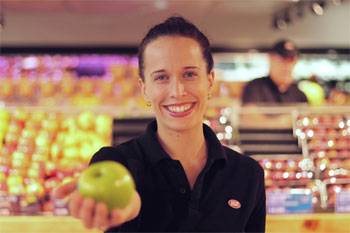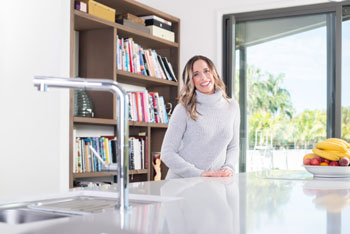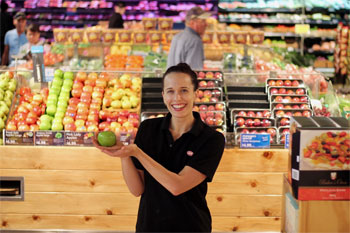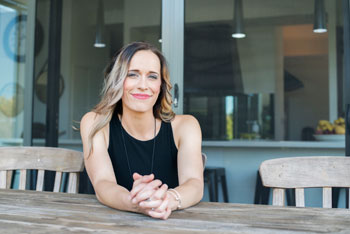Kali Gray Simple Summer Grocery Purchases Interview

Nourish Your Body and Protect Your Purse String
IGA dietitian Kali Gray who began her professional career as a dietitian and has a clinical background working with food intolerances, gut disorders and disordered eating behaviors. Kali has worked alongside chefs in recipe development, menu analysis and community cooking classes.
 Question: How can we nourish our body without spending over our budget?
Question: How can we nourish our body without spending over our budget?
Kali Gray : The key to making healthy meals on a budget lies in just a little bit of planning. This doesn't need to be time-consuming or painful. At the start of each week, I simply write down five fast dinners that appeal to me, then write the required ingredients to make these meals on a shopping list. I then add anything extra I need for lunch, breakfasts and snacks to last the week. Lastly, I have a quick scan through the cupboard and fridge to check if any staples need topping up. You'll be amazed how much you save by only buying the food you really need! With over $8 billion of household food going into Australian landfill each year, this small act of planning also reduces the environmental impact of food wastage.
Here are my other tips for eating well on a budget:
Opt for a few meat free meals. With animal protein priced in the vicinity of $10 to $20 per kilogram, chickpeas and legumes are comparatively far cheaper at only a couple of bucks a can. Plus, you'll enjoy the added health benefits of a big fibre boost from this plant based protein. Tofu and eggs are another inexpensive yet wonderful source of protein from non-meat sources.
Get Slowcookin'. Crockpots and slowcookers were once in vogue and I say bring them back! I regularly make healthy chilli con carne, split pea soup, lamb bourguignon and dahl in mine. Anything leftover goes into the freezer and is never wasted!
Savvy Staples. In the simplest sense, a well balanced meal requires four main staples: Carbohydrates, protein, fruit & veg and healthy fats. Stock your pantry with thrifty staples in each domain, so you can assemble a well-balanced and economic meal in no time:
Carbohydrates:
Potatoes (If steamed with their skin on, potatoes contain more Vitamin C than an apple!)
Sweet potato
Rice
Wholemeal pasta (gluten free if needed)
Protein:
Lentils
Split peas
Canned legumes, like chickpeas, lentils & kidney beans
Tofu (excellent source of amino acids and
Buy bulk meats on special and freeze
Canned fish
Fruit & Veg:
Frozen vegetables (buy in bulk)
Dried fruit
Seasonal fruit & veggies
Simplify. Whilst the gourmet foodie movement in Australia has many positives, the flipside is that it's tempting expect bold flavours and fancy foods at every meal. In the perfect world, raw cacao blissballs and homemade muesli bars make lovely snacks, yet in reality there's nothing wrong with a humble apple and handful of nuts when we're short on time and trying to save dollars.
Simple meals like baked beans on steamed potato with a side of steamfresh veggie bags may likewise not seem very glamorous but they are perfectly well balanced and don't break the bank. So I'd encourage you to eat simply some nights - you'll be extra grateful when there's money to splurge on the extra bells and whistles!
 Question: Why do many people think eating healthy is expensive?
Question: Why do many people think eating healthy is expensive?
Kali Gray : I hear this from clients a lot! And I think this perception comes from a few places. Firstly, many organic and high-end health products are truly more expensive. Let's face it; a bag of quinoa costs more than a bag of no-brand pasta, there's no two ways about it.
You're also more likely to remember the price of outlandishly expensive raw chocolate in the health food aisle, as compared to the very reasonably priced brown rice that you walk past every time you shop.
I think this also boils down to marketplace -cultural norms'. It never ceases to surprise me that people will happily hand over $5 for a block of chocolate or $9 for a standard tub of ice cream (which is full of fat, sugar and very little else). Yet in the same breath we'll snub spending the same amount for a punnet of vitalising, antioxidant-rich berries. The nutrient return per dollar spent is worlds apart!
Finally, perhaps we've never been shown otherwise! It's sad to me that basic life skills like cooking, budget and meal planning aren't taught in school. So many of my clients were taught to read and write, yet are totally illiterate in the kitchen. Hence why I run community cooking and food services - I think it's so integral to living well.
Question: Why is it important to eat foods that are in season?
Kali Gray : Eating seasonally has many benefits for both the health of our bodies and bank accounts:
Seasonal food is likely to be fresher! Chances are that if it's season, it probably hasn't been sitting in storage for long.
Produce that's in season is also less likely to be imported.
Fruit and vegetable reaches their natural nutrient peak when in season. Plus they're more likely to be fresh, which means you're getting more goodness out of every bite!
Seasonal items also tend to cheaper when supply is at its peak.
On an interesting aside, eating seasonally may also decrease your chances of developing a natural plant chemical sensitivity to glutamates, amines or salicylate. Intolerance to these plant chemicals is on the rise in Australia, with 1 in 100 Australians estimated now to suffer from this food sensitivity. This is approximately the same prevalence as coeliac disease! Whilst the jury's still out on exactly what causes plant chemical sensitivity, one school of thought is that it may be at least partially due to an -overload' of natural plant chemicals when we are eating out of season. Some researchers believe that eating seasonally gives your body a necessary break from certain plant chemicals; essentially avoiding any overload!
Question: What foods are good for our gut and our wallets?
Kali Gray : Our bellies la-la-LOVE fibre! In particular, much of the current gut health research is shining the spotlight on a specific type of fibre called resistant starch (RS). RS feeds the good bacteria in our gut and may help to prevent bowel cancer.
Legumes, banana (preferably not too ripe), cooked and cooled potato and rice are all excellent, inexpensive sources of RS. Other cheap, gut-loving foods are:
LSA - this is a blend of ground linseed, sunflower seeds and almonds. The essential fatty acids in LSA are anti-inflammatory and healing to the gut lining. There is also evidence to suggest that ground linseed can help to regulate bowel movements, particularly in cases of Irritable Bowel Syndrome. Just be sure to drink plenty of water to get the full benefits!
Quick tip- Look for products that contain at least 3g or more of fibre per serve.
Yoghurt - It's no secret that yoghurt contains bacteria that are good for our gut. Choose products that explicitly state a certain amount per serving, as this claim is legally binding in Australia.
Sourdough bread - it's easier to digest and contains beneficial acids that help to keep our gut healthy.
Cabbage and salt - all you need to make beautiful fermented sauerkraut at home! Very good for a healthy gut microbiota.
 Question: Can you share some gluten-free products that aren't expensive for families with food intolerances?
Question: Can you share some gluten-free products that aren't expensive for families with food intolerances?
Kali Gray : I've recently fallen in love with Teff! Available as both a seed and flour, teff is versatile in both sweet and savoury cooking and is comparatively cheaper than other -superfood' flours, such as quinoa, tigernut and the like.
I also bake a lot with LSA in replacement for almond meal. Many gluten free recipes tend to call for almond meal, which can be a little expensive. LSA replaces most nut meals in a nice 1:1 ratio and costs far less.
-Zoodles' are a cheap and nutritious alternative to gluten free pastas. Simple spiralise fresh zucchini to form your own gorgeous, crunchy, naturally gluten free spaghetti! (I heat mine just a little before serving.)
Rice flour, potato flour and tapioca flour are cheaper gluten free flours. However, they do tend to be more refined and have a lower glycaemic index. Therefore, I'll substitute half of an expensive gluten free flour in a recipe with one of these substitutes - it almost always works out.
Rice paper rolls are far cheaper than gluten free wraps and can be filled with beautiful salads, veggies and protein. These are awesome for school lunch boxes or family share food, too.
My last tip would be to get savvy with food label reading. Many, many products on the supermarket shelves are actually gluten free, even though they don't explicitly claim to be. You can save loads of dollars by learning how to label read - it will open up your range of available gluten free food options exponentially!
 Question: What are your top ten summer grocery purchases that families should be buying in the supermarket?
Question: What are your top ten summer grocery purchases that families should be buying in the supermarket?
Kali Gray : Community Co Rolled Oats – high in fibre to support good bowel health and naturally lowers cholesterol. A staple product that will often be found on special.
Community Co Sultanas – far lower glycaemic index than dates, high source of fibre to support digestive function, a natural sweetener. Very inexpensive and shelf stable so lasts a long time
Zucchini – A non starchy vegetable that offers a good source of potassium for healthy blood pressure and energizing B vitamins. Typically inexpensive at all times of year
Berries – Packed with antioxidants protective against heart disease. 1 punnet contains less sugar and carbohydrate than an apple, therefore great for blood sugar control. Berries are cheaper at this time of year when they are in season and you can also buy frozen for a more economic yet equally nutritious form.
Bananas – Greener bananas are bursting with resistant starch, which boosts healthy gut flora and may help to protect against bowel disease. Greener bananas also contain less -free sugar' and have a lower glycaemic index they are often on special too and a healthy snack for kids' lunchboxes.
Quality maple syrup – Pure, high grade Maple Syrups offer a suite of trace minerals, such as iron and is gluten free! It also provides a naturally lower glycaemic index to avoid blood sugar spikes.
Tinned lentils – Very high source of fibre, good source of protein and high in iron which is important for women and vegetarians. A tin of lentils often costs between $80c to $2 per can.
Homemade Popped Corn – Simply pop the kernels on the stove and add spice mixes. This is a simple gluten free snack packed with fibre to boost gut health and protect against bowel disease.
Cottage Cheese – Exceptionally high in protein and amino acids – important for repairing the lining of the digestive tract and very filling. It is inexpensive compared with many cheese and yoghurts.
Health Seeds - Gluten free, a great source of fibre, low GI and evidence to show linseed meal very helpful for relief of IBS. They are a cheap substitute for almond meal in virtually any recipe.
Interview by Brooke Hunter
 Question: How can we nourish our body without spending over our budget?
Question: How can we nourish our body without spending over our budget? Kali Gray : The key to making healthy meals on a budget lies in just a little bit of planning. This doesn't need to be time-consuming or painful. At the start of each week, I simply write down five fast dinners that appeal to me, then write the required ingredients to make these meals on a shopping list. I then add anything extra I need for lunch, breakfasts and snacks to last the week. Lastly, I have a quick scan through the cupboard and fridge to check if any staples need topping up. You'll be amazed how much you save by only buying the food you really need! With over $8 billion of household food going into Australian landfill each year, this small act of planning also reduces the environmental impact of food wastage.
Here are my other tips for eating well on a budget:
Opt for a few meat free meals. With animal protein priced in the vicinity of $10 to $20 per kilogram, chickpeas and legumes are comparatively far cheaper at only a couple of bucks a can. Plus, you'll enjoy the added health benefits of a big fibre boost from this plant based protein. Tofu and eggs are another inexpensive yet wonderful source of protein from non-meat sources.
Get Slowcookin'. Crockpots and slowcookers were once in vogue and I say bring them back! I regularly make healthy chilli con carne, split pea soup, lamb bourguignon and dahl in mine. Anything leftover goes into the freezer and is never wasted!
Savvy Staples. In the simplest sense, a well balanced meal requires four main staples: Carbohydrates, protein, fruit & veg and healthy fats. Stock your pantry with thrifty staples in each domain, so you can assemble a well-balanced and economic meal in no time:
Carbohydrates:
Potatoes (If steamed with their skin on, potatoes contain more Vitamin C than an apple!)
Sweet potato
Rice
Wholemeal pasta (gluten free if needed)
Protein:
Lentils
Split peas
Canned legumes, like chickpeas, lentils & kidney beans
Tofu (excellent source of amino acids and
Buy bulk meats on special and freeze
Canned fish
Fruit & Veg:
Frozen vegetables (buy in bulk)
Dried fruit
Seasonal fruit & veggies
Simplify. Whilst the gourmet foodie movement in Australia has many positives, the flipside is that it's tempting expect bold flavours and fancy foods at every meal. In the perfect world, raw cacao blissballs and homemade muesli bars make lovely snacks, yet in reality there's nothing wrong with a humble apple and handful of nuts when we're short on time and trying to save dollars.
Simple meals like baked beans on steamed potato with a side of steamfresh veggie bags may likewise not seem very glamorous but they are perfectly well balanced and don't break the bank. So I'd encourage you to eat simply some nights - you'll be extra grateful when there's money to splurge on the extra bells and whistles!
 Question: Why do many people think eating healthy is expensive?
Question: Why do many people think eating healthy is expensive? Kali Gray : I hear this from clients a lot! And I think this perception comes from a few places. Firstly, many organic and high-end health products are truly more expensive. Let's face it; a bag of quinoa costs more than a bag of no-brand pasta, there's no two ways about it.
You're also more likely to remember the price of outlandishly expensive raw chocolate in the health food aisle, as compared to the very reasonably priced brown rice that you walk past every time you shop.
I think this also boils down to marketplace -cultural norms'. It never ceases to surprise me that people will happily hand over $5 for a block of chocolate or $9 for a standard tub of ice cream (which is full of fat, sugar and very little else). Yet in the same breath we'll snub spending the same amount for a punnet of vitalising, antioxidant-rich berries. The nutrient return per dollar spent is worlds apart!
Finally, perhaps we've never been shown otherwise! It's sad to me that basic life skills like cooking, budget and meal planning aren't taught in school. So many of my clients were taught to read and write, yet are totally illiterate in the kitchen. Hence why I run community cooking and food services - I think it's so integral to living well.
Question: Why is it important to eat foods that are in season?
Kali Gray : Eating seasonally has many benefits for both the health of our bodies and bank accounts:
Seasonal food is likely to be fresher! Chances are that if it's season, it probably hasn't been sitting in storage for long.
Produce that's in season is also less likely to be imported.
Fruit and vegetable reaches their natural nutrient peak when in season. Plus they're more likely to be fresh, which means you're getting more goodness out of every bite!
Seasonal items also tend to cheaper when supply is at its peak.
On an interesting aside, eating seasonally may also decrease your chances of developing a natural plant chemical sensitivity to glutamates, amines or salicylate. Intolerance to these plant chemicals is on the rise in Australia, with 1 in 100 Australians estimated now to suffer from this food sensitivity. This is approximately the same prevalence as coeliac disease! Whilst the jury's still out on exactly what causes plant chemical sensitivity, one school of thought is that it may be at least partially due to an -overload' of natural plant chemicals when we are eating out of season. Some researchers believe that eating seasonally gives your body a necessary break from certain plant chemicals; essentially avoiding any overload!
Question: What foods are good for our gut and our wallets?
Kali Gray : Our bellies la-la-LOVE fibre! In particular, much of the current gut health research is shining the spotlight on a specific type of fibre called resistant starch (RS). RS feeds the good bacteria in our gut and may help to prevent bowel cancer.
Legumes, banana (preferably not too ripe), cooked and cooled potato and rice are all excellent, inexpensive sources of RS. Other cheap, gut-loving foods are:
LSA - this is a blend of ground linseed, sunflower seeds and almonds. The essential fatty acids in LSA are anti-inflammatory and healing to the gut lining. There is also evidence to suggest that ground linseed can help to regulate bowel movements, particularly in cases of Irritable Bowel Syndrome. Just be sure to drink plenty of water to get the full benefits!
Quick tip- Look for products that contain at least 3g or more of fibre per serve.
Yoghurt - It's no secret that yoghurt contains bacteria that are good for our gut. Choose products that explicitly state a certain amount per serving, as this claim is legally binding in Australia.
Sourdough bread - it's easier to digest and contains beneficial acids that help to keep our gut healthy.
Cabbage and salt - all you need to make beautiful fermented sauerkraut at home! Very good for a healthy gut microbiota.
 Question: Can you share some gluten-free products that aren't expensive for families with food intolerances?
Question: Can you share some gluten-free products that aren't expensive for families with food intolerances? Kali Gray : I've recently fallen in love with Teff! Available as both a seed and flour, teff is versatile in both sweet and savoury cooking and is comparatively cheaper than other -superfood' flours, such as quinoa, tigernut and the like.
I also bake a lot with LSA in replacement for almond meal. Many gluten free recipes tend to call for almond meal, which can be a little expensive. LSA replaces most nut meals in a nice 1:1 ratio and costs far less.
-Zoodles' are a cheap and nutritious alternative to gluten free pastas. Simple spiralise fresh zucchini to form your own gorgeous, crunchy, naturally gluten free spaghetti! (I heat mine just a little before serving.)
Rice flour, potato flour and tapioca flour are cheaper gluten free flours. However, they do tend to be more refined and have a lower glycaemic index. Therefore, I'll substitute half of an expensive gluten free flour in a recipe with one of these substitutes - it almost always works out.
Rice paper rolls are far cheaper than gluten free wraps and can be filled with beautiful salads, veggies and protein. These are awesome for school lunch boxes or family share food, too.
My last tip would be to get savvy with food label reading. Many, many products on the supermarket shelves are actually gluten free, even though they don't explicitly claim to be. You can save loads of dollars by learning how to label read - it will open up your range of available gluten free food options exponentially!
 Question: What are your top ten summer grocery purchases that families should be buying in the supermarket?
Question: What are your top ten summer grocery purchases that families should be buying in the supermarket? Kali Gray : Community Co Rolled Oats – high in fibre to support good bowel health and naturally lowers cholesterol. A staple product that will often be found on special.
Community Co Sultanas – far lower glycaemic index than dates, high source of fibre to support digestive function, a natural sweetener. Very inexpensive and shelf stable so lasts a long time
Zucchini – A non starchy vegetable that offers a good source of potassium for healthy blood pressure and energizing B vitamins. Typically inexpensive at all times of year
Berries – Packed with antioxidants protective against heart disease. 1 punnet contains less sugar and carbohydrate than an apple, therefore great for blood sugar control. Berries are cheaper at this time of year when they are in season and you can also buy frozen for a more economic yet equally nutritious form.
Bananas – Greener bananas are bursting with resistant starch, which boosts healthy gut flora and may help to protect against bowel disease. Greener bananas also contain less -free sugar' and have a lower glycaemic index they are often on special too and a healthy snack for kids' lunchboxes.
Quality maple syrup – Pure, high grade Maple Syrups offer a suite of trace minerals, such as iron and is gluten free! It also provides a naturally lower glycaemic index to avoid blood sugar spikes.
Tinned lentils – Very high source of fibre, good source of protein and high in iron which is important for women and vegetarians. A tin of lentils often costs between $80c to $2 per can.
Homemade Popped Corn – Simply pop the kernels on the stove and add spice mixes. This is a simple gluten free snack packed with fibre to boost gut health and protect against bowel disease.
Cottage Cheese – Exceptionally high in protein and amino acids – important for repairing the lining of the digestive tract and very filling. It is inexpensive compared with many cheese and yoghurts.
Health Seeds - Gluten free, a great source of fibre, low GI and evidence to show linseed meal very helpful for relief of IBS. They are a cheap substitute for almond meal in virtually any recipe.
Interview by Brooke Hunter
MORE





